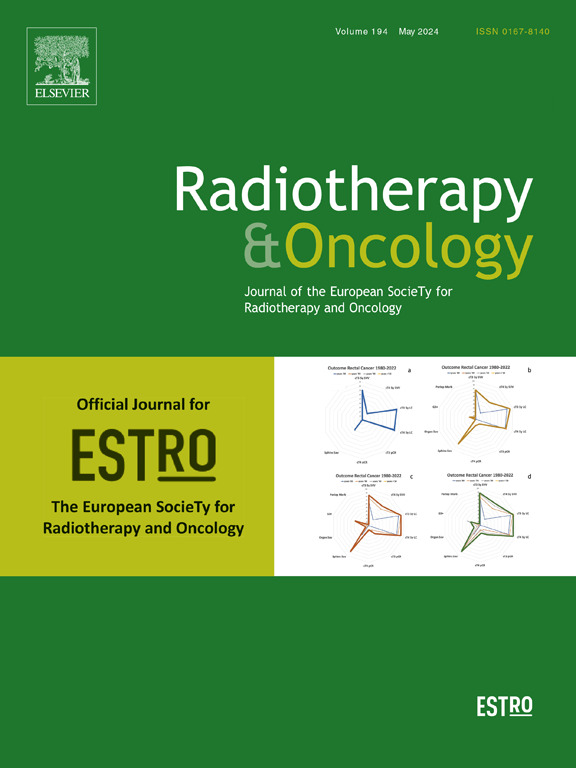放射治疗中剂量带预测的可行性研究:预测计划剂量谱
IF 4.9
1区 医学
Q1 ONCOLOGY
引用次数: 0
摘要
目的:目前基于深度学习的剂量预测方法只能预测一种剂量分布。如果预测的剂量不准确,则无法选择其他选项。为了克服这一局限性,我们提出了一种名为 "剂量带预测 "的新型剂量预测方法,该方法可为规划和质量保证(QA)目的提供一系列预测剂量分布:我们利用三维神经网络中的上/下带损失建立了上/下带模型(UBM/LBM)。UBM/LBM中预测的最大/最小合理剂量定义了每个体素的理想剂量谱。我们在研究中选取了 104 例鼻咽癌病例进行断层治疗(数据集 1),54 例宫颈癌病例进行 IMRT 治疗(数据集 2),37 例宫颈癌病例进行 VMAT 治疗(数据集 3)。此外,在数据集 3 中还进行了基于剂量带的自动规划(Auto-plandose-band)尝试,并与 MSE 模型(Auto-planMSE)进行了比较:结果:UBM/LBM 剂量往往高于/低于临床剂量,形成了预测的剂量谱。中线剂量代表上/下波段的平均值,与临床剂量一致。在数据集 1 中,上波段、中线和下波段的规划靶体积(PTV)和危险器官(OAR)的平均差异分别为 3.66 %、-0.40 % 和 -4.48 %;在数据集 2 中,它们分别为 2.40 %、-1.62 % 和 -5.57 %;在数据集 3 中,它们分别为 2.18 %、-0.59 % 和 -3.31 %。当 PTV 符合处方要求时,OARs 中的 Auto-plandose-band 和 Auto-planMSE 的平均差异为 -2.67 %:剂量带预测成功预测了剂量谱,使自动规划和质量保证变得灵活且高质量。本文章由计算机程序翻译,如有差异,请以英文原文为准。
A feasibility study of dose-band prediction in radiation therapy: Predicting a spectrum of plan dose
Purpose
The current deep learning-based dose prediction methods only predict one dose distribution. If the predicted dose is inaccurate, no additional options can be selected. To overcome this limitation, we propose a novel dose prediction method called “dose-band prediction,” which provides a spectrum of predicted dose distributions for planning and quality assurance (QA) purposes.
Material and methods
We utilized Upper/Lower-band losses in 3D neural networks to establish the Upper/Lower-band models (UBM/LBM). The maximum/minimum rational dose predicted in UBM/LBM defined the ideal dose spectrum for each voxel. We enrolled 104 nasopharyngeal carcinoma cases with tomotherapy (dataset 1), 54 cervical carcinoma cases with IMRT (dataset 2), and 37 cervical carcinoma cases with VMAT (dataset 3) in the study. Moreover, a dose band-based auto planning (Auto-plandose-band) attempt was carried out in dataset 3, compared with the MSE model (Auto-planMSE).
Results
The UBM/LBM doses tend to be higher/lower than the clinical dose, forming a predicted dose spectrum. The Middle-line dose represents the average of the Upper/Lower-band, which was consistent with the clinical dose. The mean differences of the planning target volumes (PTVs) and organs at risk (OARs) for the Upper-band, Middle-line, and Lower-band in Dataset 1 were 3.66 %, −0.40 %, and −4.48 % in Dataset 2, they were 2.40 %, −1.62 %, and −5.57 %; in Dataset 3, they were 2.18 %, −0.59 %, and −3.31 %. When PTVs meet prescription, the mean difference between Auto-plandose-band and Auto-planMSE in OARs was −2.67 %.
Conclusion
The dose-band prediction successfully predicted a spectrum of doses, making auto-planning and QA flexible and high quality.
求助全文
通过发布文献求助,成功后即可免费获取论文全文。
去求助
来源期刊

Radiotherapy and Oncology
医学-核医学
CiteScore
10.30
自引率
10.50%
发文量
2445
审稿时长
45 days
期刊介绍:
Radiotherapy and Oncology publishes papers describing original research as well as review articles. It covers areas of interest relating to radiation oncology. This includes: clinical radiotherapy, combined modality treatment, translational studies, epidemiological outcomes, imaging, dosimetry, and radiation therapy planning, experimental work in radiobiology, chemobiology, hyperthermia and tumour biology, as well as data science in radiation oncology and physics aspects relevant to oncology.Papers on more general aspects of interest to the radiation oncologist including chemotherapy, surgery and immunology are also published.
 求助内容:
求助内容: 应助结果提醒方式:
应助结果提醒方式:


